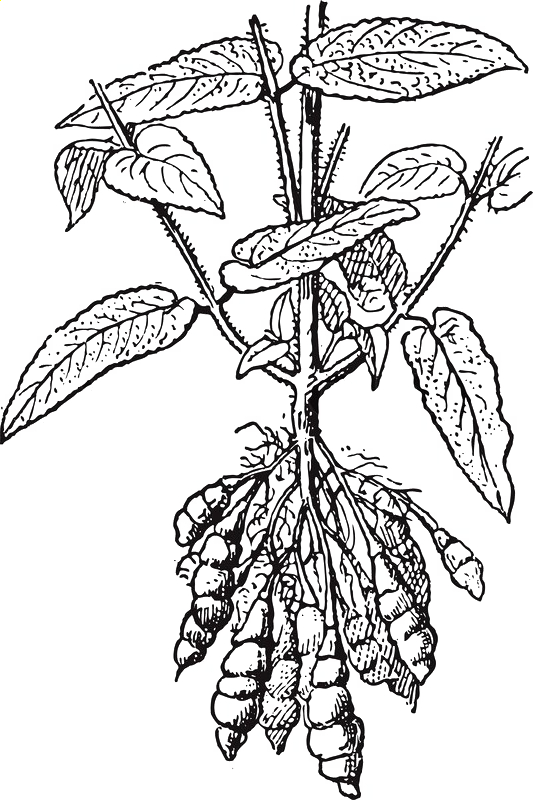 Chinese Artichoke and Other Tuberous Mints
Chinese Artichoke and Other Tuberous Mints
Overview
- Chinese artichoke is a tuber crop native to China, Japan, and Korea.
- This crop is easy to grow in the Pacific Northwest and in much of the rest of the US.
- Chinese artichoke tubers are small, reaching about one to two inches in diameter on average.
- Typical yield is about four to six ounces per plant.
- The tubers white and segmented, looking a bit like grubs.
- There are other species of tuberous mints in the genera Lycopus and Stachys.
- Florida betony is a native North American tuber that is larger and higher yielding than Chinese artichoke.
- Marsh woundwort is a widespread species that produces longer, but usually thinner tubers than Chinese artichoke.
- The bugleweeds are related species that typically produce tubers that are larger, but more bitter.
- Chinese artichoke is propagated by planting tubers. Other tuberous mints can also be grown from seeds.
About Tuberous Mint
Description
I’ve done something here that I normally try pretty hard to avoid: introducing a new name for a well known plant. In this case, a name for a group of plants. There are several edible, tuberous species in the mint family, Lamiaceae. The most well known of these is the Chinese artichoke (Stachys affinis). There are at least three genera of tuberous mint: Lycopus, Plectranthus, and Stachys. Of these, only the members of Lycopus and Stachys will grow well in the Pacific Northwest, so I will focus on those. (Plectranthus is a tropical genus and, sadly, only grows well in tropical or subtropical climates.) The temperate species have similar growth habits, cultivation details, and culinary uses, so we can lump them together for the most part.
The tuberous mints covered in this chapter include Chinese artichoke (Stachys affinis), Florida betony (Stachys floridana), marsh woundwort (Stachys palustris), Chinese bugleweed (Lycopus lucidus), northern bugleweed (Lycopus uniflorus), and rough bugleweed (Lycopus asper). There are other edible members of each genus, but I have not grown them yet.
If you have seen mint plants, the Stachys species will look familiar. They have the signature small, serrated leaves and angular stems of the mint family. The Lycopus species tend to be a little larger and sturdier. These plants are best grown where they can establish as a perennial population, because it is very hard to find all of the tubers when you harvest. Some of them can be pretty invasive if you don’t take measures to contain them. Once you have grown mint tubers, you could be growing them forever.
Chinese Artichoke, Crosne, Chirogi, Gan Lu Zi, 甘露子 (Stachys affinis)
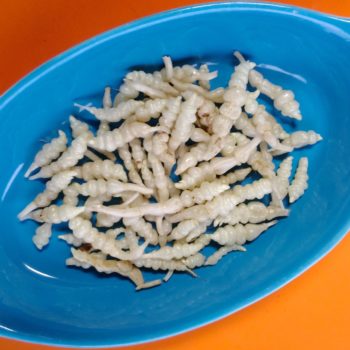
The most well known of the tuberous mints is Stachys affinis, the Chinese artichoke. The tubers of Chinese artichoke are generally small, two to three inches (5 to 7.5 cm) in length, and no more than half an inch (1.2 cm) wide. They are white, with a segmented appearance that makes them tempting to compare to grubs. They are crisp and slightly nutty tasting and are often eaten raw, but also can be cooked or pickled. All parts of the plant are edible, but only the tubers are really worthwhile, in my opinion. Yields are fairly small; a quarter pound (114 g) from an individual plant is very good. Chinese artichoke plants reach about 18 inches (45 cm) in height. Chinese artichoke is diploid.
In most places, Chinese artichoke is one of those plants that you really have to grow yourself. It is rarely available in markets and it doesn’t store very well. In climates where the soil doesn’t freeze to significant depth, it is best harvested and used fresh through fall and winter. A fresh Chinese artichoke tuber has the texture of a radish, with a flavor that combines elements of radish, turnip, and walnut (in my opinion of course), while tubers that have been sitting in a box at the store for more than a day or two may have no flavor at all.
Florida Betony (Stachys floridana)
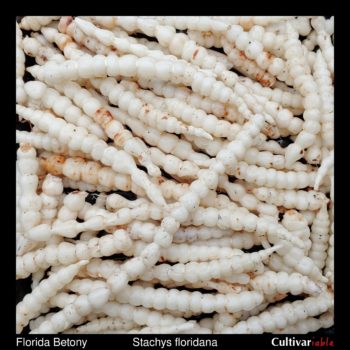
Florida betony is quite similar to Chinese artichoke, but the tubers are usually quite a bit larger. The flavor is less nutty, more bland. I think this species has great potential compared to Chinese artichoke, because it generally has better yields and readily produces seed, which means that it can be more easily improved through breeding.
The tubers of Florida betony may reach up to twelve inches (30 cm) in length and about three quarters of an inch (2 cm) in diameter. Florida betony plants reach up to about 24 inches (60 cm) in our climate.
Marsh Woundwort (Stachys palustris)
Marsh woundwort tubers may grow as long as eighteen inches (46 cm) although most of that lenth is rather thin. It is still perfectly edible and may even be preferable for some dishes. I find that the thicker, more useful part of the tubers is typically about four to six inches (10 to 15 cm) in length. Marsh woundwort plants reach up to about 40 inches tall (102 cm) in our climate. Marsh woundwort is found in diploid, tetraploid, and hexaploid forms. The diploids and tetraploids are mostly native to North America, while the hexaploids are mostly native to Europe (Luczaj 2011).
Northern Bugleweed (Lycopus uniflorus)
Lycopus uniflorus is generally considered to be the most edible of the genus, at least judged by the accounts of its use. It was used by a number of native American peoples and was a staple food of the Okanagan, who consumed it steamed or baked (Moerman 1998). Tuber size is generally quite small. rarely exceeding the diameter of a pencil.
Rough Bugleweed (Lycopus asper)
Lycopus asper is a widespread species in North America. The Chippewa used it dried or boiled (Moerman 1998). It has a bit of a bitter aftertaste, but nothing too unpleasant. Rhizomes are intermediate in size between L. uniflorum, which is smaller, and L. lucidus, which is larger. The Iroquoi used it as a laxative, so it is probably a good idea to take it slowly when introducing this plant to your diet. The part used for the laxative preparation is not specified, so it could have been the leaves rather than the rhizomes.
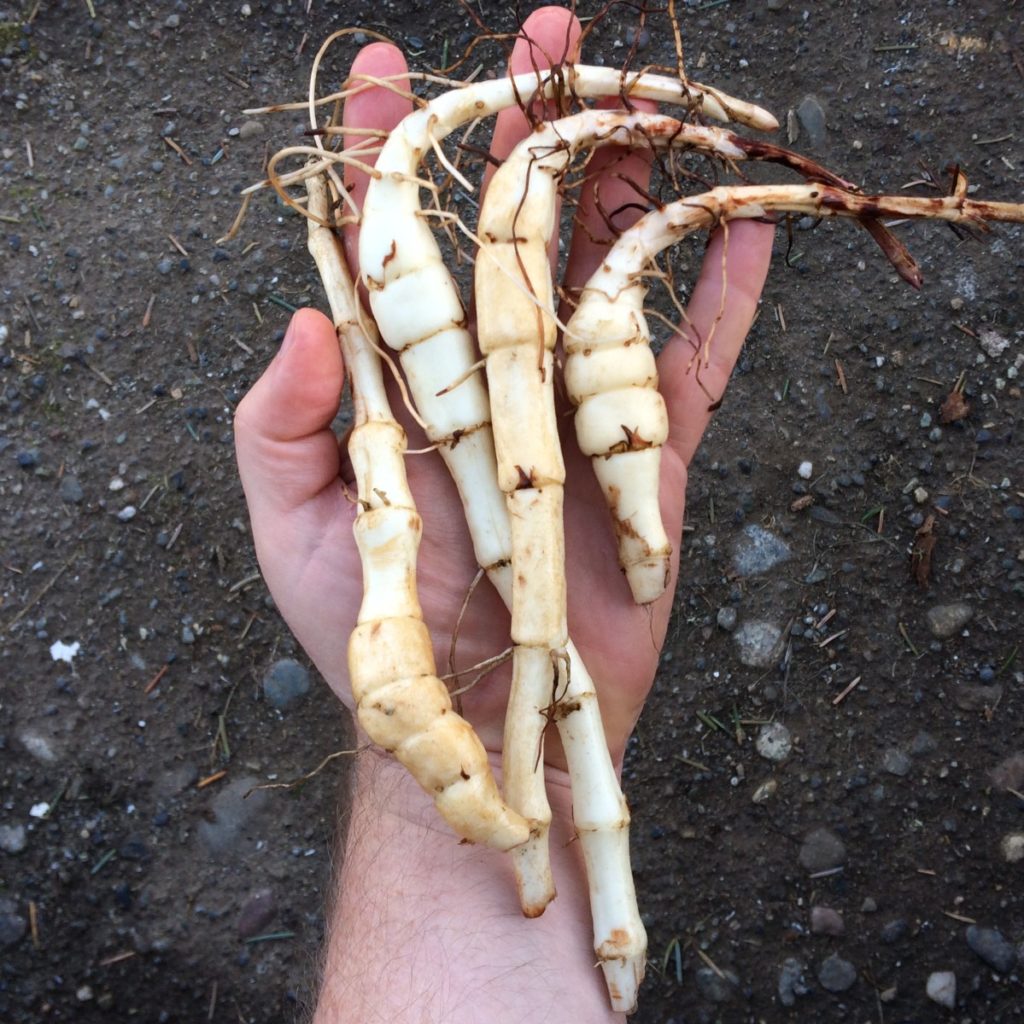
Chinese Bugleweed, Ajekoshi, Shirone, Di Sun, 地笋 (Lycopus lucidus)
Lycopus lucidus is used in Chinese medicine, but there is very little information about its use as a vegetable. It is eaten boiled or preserved in salt in both China (Zhang 1991) and Japan (ASJ 1895). I don’t get the sense that is is a common vegetable in either place, based on the paucity of information, although it is possible that there is more information available in Chinese or Japanese sources that I cannot access. It makes some of the largest tubers among the tuberous mints. The plants are also very attractive with woody stems and glossy leaves, looking more ornamental than the other species listed here.
History
These plants are mostly undomesticated or relatively recent to cultivation. Chinese artichoke cultivation began in northern China around the thirteenth century. Marsh woundwort may have been cultivated in eastern Europe in the nineteenth and twentieth centuries and in Britain prior to the introduction of the potato (Luczaj 2011). Marsh woundwort, Florida betony, northern bugleweed, and rough bugleweed were used by native Americans.
Marsh woundwort was used as a food in Poland and Ukraine, both raw and as a flour that was used as a thickener or to stretch bread dough (Luczaj 2011).
Nutrition
Relatively little information is available about the nutritional values of any of the mint tubers. All six species employ stachyose as their primary carbohydrate, although they also contain a smaller portion of starch. Stachyose is not digestible by humans, so these tubers are relatively low in calories. As with most vegetables that contain indigestible sugars, excessive consumption may cause gas. This is not usually a problem with tuberous mint since it is generally consumed in smaller portions than other roots with indigestible sugars, such as Jerusalem artichoke and yacon.
The tubers of Chinese artichoke are considered to be high in iron, although I couldn’t find an original source for this information.
Cooking and Eating
Tubers of the Stachys species can be eaten raw or cooked. Most accounts specify that the Lycopus tubers were only eaten cooked. I have tried some raw and it didn’t kill me, but I can’t recommend it without more experience. The crunch Stachys tubers made a good addition to salads. Cooking is generally done for short periods of time. Stir frying works very well. Steaming or briefly boiling for two to four minutes also produces good results.
In China, Japan, and Korea, Chinese artichoke is often fermented. This both serves to preserve it and increases the fraction of digestible sugars. Ingredients are sometimes added to color the tubers; in Japan, perilla is added to color them red.
Cultivation
Climate Tolerance
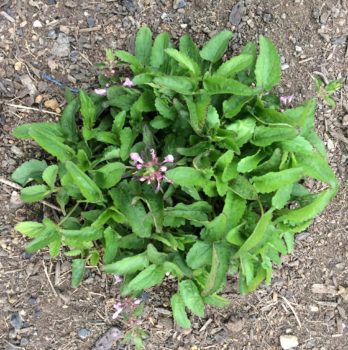
Tuberous mints need plenty of water. They are not drought tolerant plants, but they will succeed under a wide temperature range. Marsh woundwort and the Lycopus species are the most tolerant of chilly conditions, while Florida betony is the most heat tolerant, and Chinese artichoke falls somewhere in between. In our garden, Florida betony and the Lycopus species survive the coldest weather (into the mid 20s F (around -4 C), but Marsh woundwort grows better in cold conditions.
Tuberous mints need a consistent supply of water to produce good yields. If the soil is allowed to dry out too frequently, yields will suffer. Full sun is also required to produce good yields; although tuberous mints will happily grow in shade, they don’t receive the energy necessary to form lots of tubers.
All six plants should be hardy (as tubers) down to USDA zone 6. Chinese artichoke is typically hardy down to USDA zone 5 (zone 4 under mulch), Florida betony to USDA zone 6, and marsh woundwort is unknown, but probably suitable for zone 5/6. The American Lycopus species grow in some of the coldest parts of the country, so they are probably good down to zone 4. Chinese Bugleweed is unknown. The tubers have survived freezing here down to 25F, but sprouts that were emerging from the tubers died back. So, they might have difficulties below about zone 7. The foliage will die by the time temperatures reach the lower 20s F (less than -4 C) but the tubers are set fairly deep and survive shallow freezing pretty well. These ratings are for plants in the ground; in containers where they can’t form tubers as deeply, they may be less hardy.
Photoperiod
None of these plants have any photoperiod dependencies. That’s a refreshing change!
Soil Requirements
Marsh woundwort prefers wet and probably acidic soil. The weight of tubers produced in pots was found to be roughly two to four times greater in wet soil than dry (Wilcock 1974). This is not particularly surprising, given that the native environment of marsh woundwort is, well, marshes.
Soil should drain well and be in the vicinity of neutral pH for Chinese artichoke.
Little information is available about optimum soil conditions for Florida betony and the Lycopus species, but they perform well in the same soil conditions as Chinese artichoke for us. The fact that Florida betony is a noxious weed of lawns throughout the Southeast suggests that it probably tolerates a wide range of soil conditions.
Propagule Care
Mint tubers are particularly vulnerable to dehydration and will do better stored in soil than exposed to the air. Keep them in a dark, cool place, in slightly damp soil. Tubers will quickly become soft when exposed to air, but they can be rehydrated simply by potting them in some damp soil. In general, the larger the tubers, the more quickly they suffer from dehydration.
Seed of marsh woundwort and Florida betony has a storage life of at least 3 years at 50° F (10° C).
Planting
We have experimented with both spring and fall planting for all of these species and haven’t found that it makes much difference. I would plant them as soon as possible, since it can be hard to store the rhizome in good condition.
In row spacing of nine to fifteen inches (22.5 to 37.5 cm) works well. Tighter spacing should only be used where water is abundant. I plant on a fifteen inch spacing, which seems to increase the number of large tubers. Thirty inch (75 cm) row spacing will leave a comfortable walkway. Plants are best grown in raised beds so that they cannot spread out of control.
Starting from Tubers
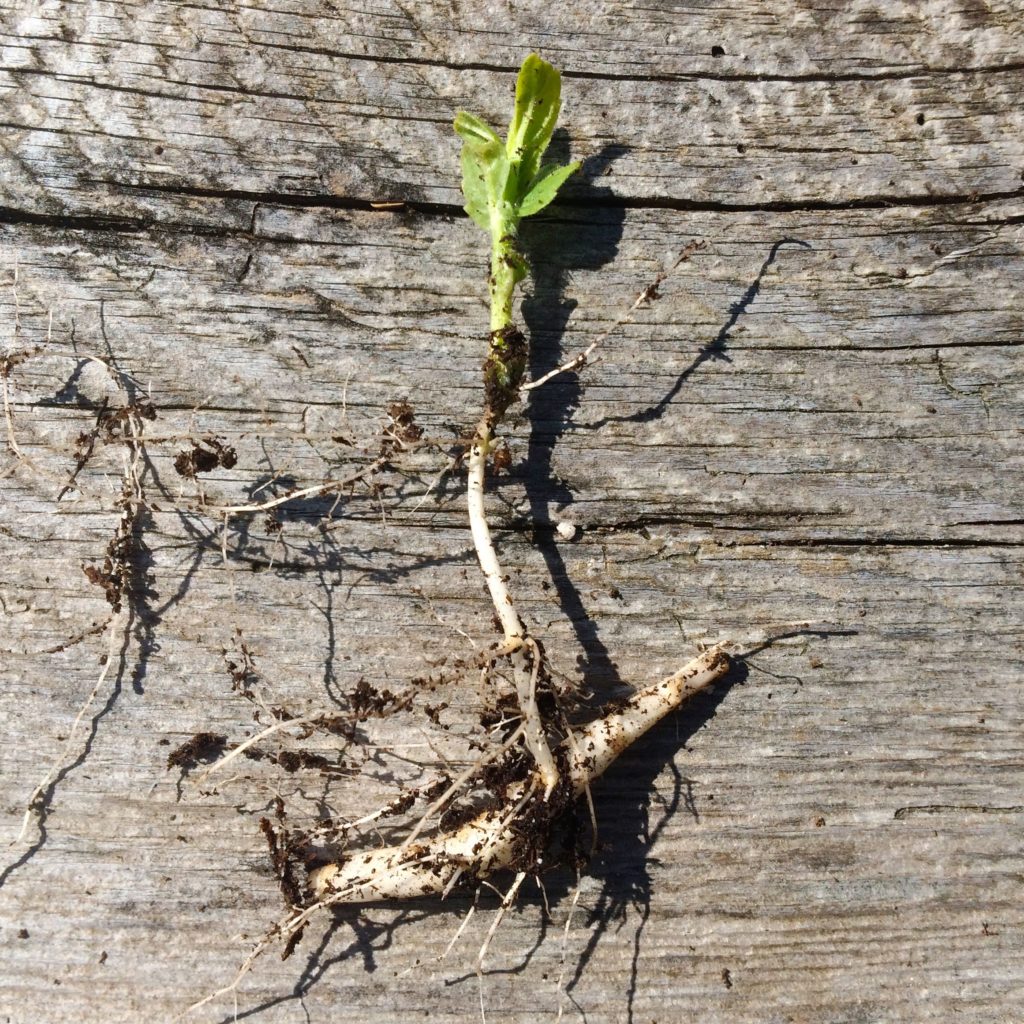
Tubers can be planted in fall or spring in mild climates. Florida betony foliage grows fastest under warm temperatures (in the 70s F) and long day conditions (McElroy 2002). Presumably, increased growth in long day conditions is due simply to the increased amount of sunlight. This information appears to be true for Chinese artichoke and marsh woundwort as well, although I haven’t studied it carefully.
You can cut tubers for more plants, much as you would seed potatoes. Make sure each piece has at least three segments for best results. Plant two to three inches (5 to 7.5 cm) deep, preferring deeper planting for larger tubers. Orientation of the tuber doesn’t appear to matter, but I plant them horizontally, which is generally how they are found when dug.
Dormancy varies considerably among the six species here. Marsh woundwort emerges earliest, in late winter. Chinese artichoke and the Lycopus species emerge in early spring. Florida bettony doesn’t wake up until mid-spring.
Starting from Seeds
Florida betony seeds will germinate over several weeks at 70° F (21 C) and should be started four to six weeks before your last frost.
Marsh woundwort requires stratification, at least two months of cold, wet conditions, after which it will germinate over two to three months at 70° F. This requires some planning. I begin stratification in November and then sow the seeds indoors in pots in February.
No information is available about germinating Chinese artichoke seeds, due to their rarity. I would guess that their requirements are more similar to Florida betony than marsh woundwort.
Lycopus seeds are not reported to require stratification, but mine have germinated a lot better with 30 days of cold, wet stratification. More testing require.
Management
Where you have grown tuberous mints previously, you must thin the new plants in the spring to your preferred spacing. Failure to thin will result in crowding and poor yields of small tubers.
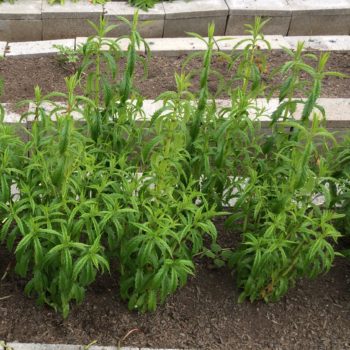
Many sources recommend keeping the foliage of Chinese artichoke trimmed back to about six inches (15 cm) in order to maximize the size of the tubers. I haven’t found this to be necessary and it doesn’t make a lot of sense to me either. Our plants grow quite large, up to about two feet (60 cm) tall, and they produce large numbers of tubers. Ostensibly, the reason for trimming the plants is to prevent flowering and the loss of energy that the plant will divert into trying to form seed. I have had some plants flower and, as far as I could tell, it didn’t make much difference in yield. The closely related Florida betony, which flowers profusely, also provides very good tuber yields. So, you might experiment with keeping the plants trimmed to see how it works for you, but I don’t recommend that you adopt it as standard practice without some testing.
In parts of the southeast, Florida betony is considered a noxious weed. The same is true for marsh woundwort in parts of Europe, where it is a common weed in cereal, potato, and beet plots (Luczaj 2011). All six species can become difficult to control in almost any climate, since even tiny pieces of rhizome can generate a new plant. It is best to grow these plants in pots or in a hard sided bed. Although they are normally shallow rooted, they may set tubers as deep as 18 inches (45 cm) if they are stopped by an obstacle, which means that they can escape from under beds with short walls.
Companion Planting
All six species can make good understory plants for shrubs or trees. The only problem is that they will probably escape your control in such an environment and become very weedy. As essentially wild plants, they are very good at taking care of themselves in a mixed planting. Maybe too good.
Growing as a Perennial
All six species are suitable for growing as perennials. In fact, it may be quite difficult to grow them in any other way. The large number of small tubers makes these plants nearly impossible to harvest completely and even small fragments of rhizome can easily produce new plants. Hard sided beds can be used for a perennial patch. You also might experiment with using animals for control. Our patch is located where ducks can reach three sides through a fence. This prevents escape to those sides because the ducks eat all of the tubers.
Marsh woundwort is particularly good at escape, but all six will easily find the gaps between cement blocks or wood slats and try to make their escape into the larger garden. Do not establish a patch where you plan to rototill in the future. Rototilling is a very efficient way of spreading tuberous mints.
Container Growing
Tuberous mint grows very well in containers of three gallons (11 l) or larger size.
Harvest
In cool summer climates, tubers are generally harvested in fall. In frost free climates, they may be best harvested in spring.
Tubers are ready for harvest any time after the foliage dies back in the fall. The tubers can be rather deep. Florida betony tubers are typically formed 4 to 6 inches deep, but Chinese artichoke and marsh woundwort may form tubers anywhere from 8 to 18 inches deep and sometimes even deeper where they run into obstructions like the sides of a raised bed.
Storage
The tubers keep very poorly out of the ground. They dehydrate rapidly and must be stored under cool, high humidity conditions. They also tend to discolor. Because of this, they are best left in the ground and harvested as needed in climates where the ground doesn’t freeze.
They will last up to a week in the crisper drawer of a refrigerator without much decline in quality. Lightly wetted and sealed in a plastic bag, they can be stored through the winter for replanting in the spring, although this should be necessary only in very cold climates or where animals eat the tubers.
Preservation
Tubers are traditionally pickled in Japan and that may be the only good way of preserving the tubers. They can potentially be dried and ground into flour.
Propagation
All varieties of all six species are hybrids, so varieties can only be maintained through vegetative propagation.
Vegetative Propagation
You can propagate all of these plants with tubers, rhizome, or stem cuttings. For stem cuttings, take four to six inch (10 to 15 cm) sections of stem and set the bottom about two inches (5 cm) deep in damp soil. Significant root formation takes six to eight weeks, after which the new plant can be hardened off and moved outside.
Sexual Propagation
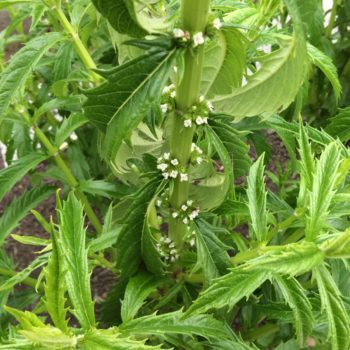
Chinese artichoke rarely flowers or sets seed. Flowers are primarily formed in warm, dry weather. I had good flowering from the plants one year during a period of unusually warm weather. There have been some breeding programs that managed to get seed from Chinese artichoke, so it is possible. If you ever see your plants flowering, make sure to try to collect the seed!
Marsh woundwort and Florida betony set seed easily. It matures over a long period of time and can be difficult to collect. I tuck white plastic grocery bags around the base of the plant and collect the seeds that fall on them.
Hybrids of marsh woundwort exist in nature, so crosses with other wild relatives may be a way to increase genetic diversity in this crop (Wilcock 1974).
I have observed moderate pollinator interest in these plants, primarily from bumble bees, flies, and occasionally butterflies. If you are in an area where they migrate, monarch butterflies may visit Florida betony.
Problems
Pests
Spider mites and tarnished plant bug sometimes become serious pests.
Diseases
Chinese artichoke, at least, is commonly infected with viruses. These eventually reduce yield. The only remedy is to abandon the current plot, killing off the volunteers by covering the soil with plastic and starting again with new tubers in new ground.
Defects
Marsh woundwort sometimes develops a condition where it no longer produces tubers, but only slightly thickened stolons. The condition is persistent and may be the result of a mutation or disease.
Crop Development
Two common development goals for these crops must be increasing the size of the individual tubers and the per plant yields. They would also benefit from a reduction in the depth of the eyes so that they would retain less soil.
In Chinese artichoke, restoring fertility by growing plants from seed or by crossing with other members of the genus Stachys could make further breeding possible.
Relatives
Lycopus rubellus
I have read that L. rubellus is also a good edible, but I haven’t been able to find a source to try it.
What You Will Receive
We supply either whole or cut tubers. Chinese artichoke tubers are typically provided whole. Florida bettony and marsh woundwort are typically provided in roughly three inch long segments.
9 thoughts on “Chinese Artichoke and Other Tuberous Mints”
Leave a Reply
You must be logged in to post a comment.

I believe Kurt Stueber’s photo of Chinese artichoke is the wrong species of Stachys. I have grown lots of Stachys affinis and many other species of tuberous mints of the genera Stachys and Lycopus and those plants are much too upright in form to be Stachys affinis, in my opinion. Stachys affinis has a sprawling growth habit quite different from these plants he shows and the flowering shoots are not the same either. These look much too compact and tall in their flower spikes, and also the leaves are much more strap-like than any I have ever seen on S. affinis. I contacted Kurt once about this but he wouldn’t listen. The incorrectly identified photo is getting picked up off the web and used too often as an example of S. affinis.
Thanks for letting us know, Steve! I’ll fix that.
Thank you for the great information, I just learned about Chinese artichokes and want to grow some. You have provided some things for me to know and how to care for them, since I grow a lot in pots, cause the soil around my house is mostly sand and I don’t get good to any grow from it. Can’t wait to get some to grow and eat. Thanks
In zone 8, these are weeds which take over any yard. I may have to eat some but this will Not remove them. The roots spread during our winter. They invade everywhere. Yet, I am glad to know what it is.
I’m in zone 8 and they don’t take over here, but zone 8 PNW and zone 8 in the South/SE have a lot of differences. I do recommend that people grow these plants in pots, because any of them can be invasive in the right place.
Zone 9a here in Florida. Florida betony, Oxalis, and Purslane are all healthy robust weeds. Especially would like to get rid of the Oxalis! Why can’t we from a sample tissue get a genome specific Oxalis herbicide, probably the ‘wave’ of the future.
Hi,
I think I found a reference for the edibility of Lycopus lucidus : https://www.youtube.com/watch?v=qBBKlLBV-uQ
Regards,
Thanks! That was an interesting video.
Thank you! Thanks to you, I found out that the plant in my collection is called Lycopus and not Stachys.
Volodymyr. Ukraine.